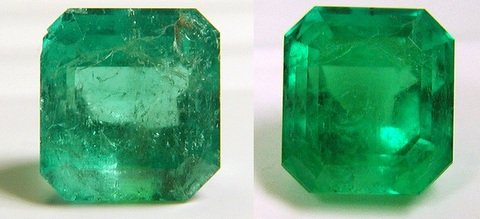
Oiled Emerald – Before and After
In my first blog this month, I wrote about emeralds: all of their wondrous beauty, their allure, and their chaotic origins. But I mentioned, almost in passing, that emeralds need some extra care. I didn’t have room in that entry, so I’m going to expound on that notion here.
If you’ll recall (or pull up that blog, if you wish), emeralds are classified as a Type III Gemstone. That means that even in the finest stones, there will be some form of inclusion, and the majority of faceted emeralds will tend to be heavily included and flawed. These inclusions are usually internal fractures and fissures that greatly affect the clarity. Sometimes they’re prevalent enough to destabilize an emerald’s physical structure. This is the result of how an emerald is formed, and it’s a nearly universal problem in this variety of gemstone.
The easiest way to avoid an unstable emerald is to not buy cheap, crappy emeralds. This really is one of those instances where you get what you pay for. Finer stones cost more, but they are also carefully vetted for major structural defects that would make them overly sensitive. If there’s a question about an emerald’s stability, it’s dropped out of the finer grades because of it. But there will still usually be lots of little inclusions or one major inclusion in upper class stones.
Due to that, virtually all emeralds – even the best of the best – are coated with certain oils or resins to fill any surface-reaching cracks and fissures. Cedar oil is the historic choice and is still widely used, but there is a modern synthetic substance called Opticon that is common nowadays. This treatment is called “oiling,” and it is as time-honored in emeralds as waxing is in jade and turquoise. It doesn’t permanently change the emerald, nor does it harm the emerald in anyway, and it is infinitely repeatable at no detriment to the emerald.
This treatment improves the clarity of a stone by lowering the relief of the fracture in profile. Steam and ultrasonic cleaning can remove this treatment. Once the filler is removed, the stone will look cloudier, and you may notice the inclusions more prominently. Steam and ultrasonic cleaning are also a bad idea because they can propagate any existing structural defects, but there’s a fairly long list of gems that’s true for; emerald isn’t alone in that. Oiling will wear off over the course of many years, but, as I said, it can be successfully redone without harming your emerald.
In short, if you have questions about an emerald you own, just bring it in to the store, and we’ll give your jewelry a free complimentary inspection and cleaning. My staff and I are always happy to help you and answer your questions.
Tags: blog, clarity, emeralds, faceted, inclusions, jewelry, waxing